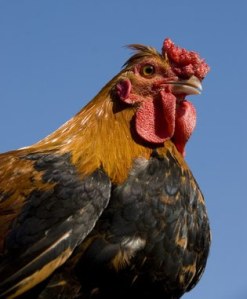A “True” Story of About a Rooster and Some Wine
The history of that now famous “coq-au-vin” recipe is actually drawn from a pretty grisly period in French history – namely the French Revolution where, all too frequently, “off with his head” became synonymous with the ideals of liberté égalité et fraternité.
Now, it just so happens that in the French countryside, in Bourgogne as a matter of fact, there lived a farmer with just a few sou (not Euros) to his name, the “farmer’s daughter”, his dear wife and his rooster. Soon enough, the authorities came knocking at his door accusing him of high crimes and general all around treason against France. Unable to dissuade his Republican welcoming committee, he gestured to his wife, perhaps? Then maybe his daughter peut-etre? Nothing, not a toothless grin or even a citoyen leer that is until they saw Monsieur le Rooster. It was as if time stood still and the farmer quickly realized that the rooster would be his savior and gladly offered rooster’s neck rather than face a very close shave. One swift terrible slice of the hatchet later, the old bird found himself neck-deep in country wine so as to better tenderize his leather hide. The farmer’s wife threw in some lardons, des onions, champignons, et des epices and added what was left of their potatoes from their humble little cave au pomme de terre. Monsieur le coq stewed for several hours during which much wine was consumed, speeches were made, everybody became a citoyen or citoyenne, equals one and all. After such a sumptuous meal, the citizen guards left happy and very content but no more so than the farmer. Every year since then, the farmer celebrated the saving of his neck with the killing of a rooster. That is the “true” history of the first ever “coq-au-vin”as a classic in French cuisine. Of course, if you don’t believe me ask the rooster.
PERHAPS THERE IS MORE TO THE STORY?
There are some who say it really started with Caesar during his conquest of Gaul and who knows perhaps having slaughtered enough Gauls, he decided to slaughter their fowl for fun and food. Caesar, as we all know, eventually returned to Rome and met his fate. Coq-au-vin with a Roman twist.
This is an interesting recipe for Coq-au-vin circa 1938
Coq-au-vin (d’apres une recette ancienne).–Depecez en six quartiers un jeune poulet de Limagne. En un pot de terre, faits revenir dans 45 g de beurre, 90 g lde larde maigre, taille en des et petits oignons. Lorsqu’ils sont revenus, jetez en votre pot lest quartiers de poulet, une gousse d’ail hachee menue, un bouquet garni, morilles ou champignons. Faites dorer a couvert sur feu vif, decouvrez, degraissez. Arrosez d’un doigt de bonne eau-de-vie, flambez et repandez sur le tout un demi-litre de vin viex d’Auvergne. Apres cuisson sur feu vif, sortez le poulet, arrosez-le de sa sauce liee au beurre manie.”
—Larousse Gastronomique, Prosper Montagne [Librarie Larousse:Paris] 1938

